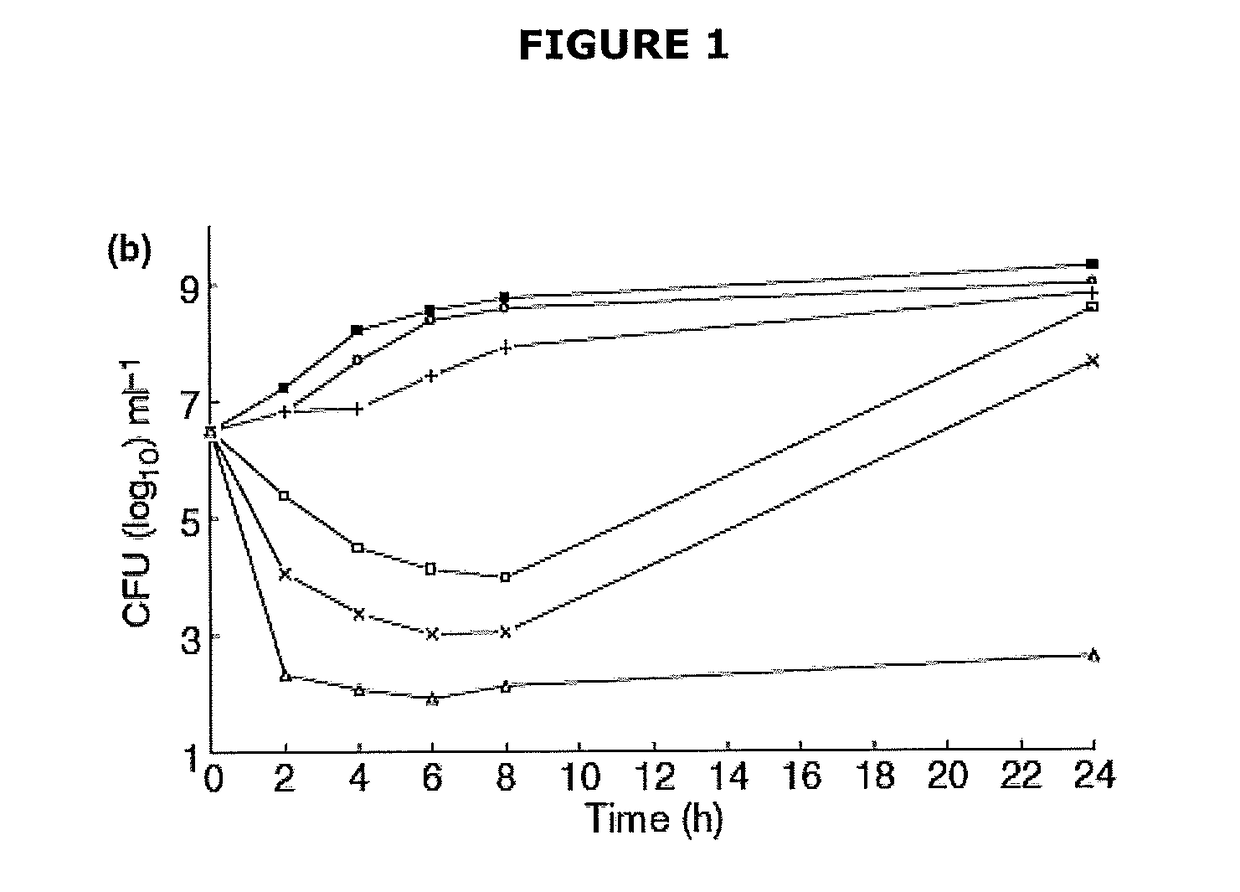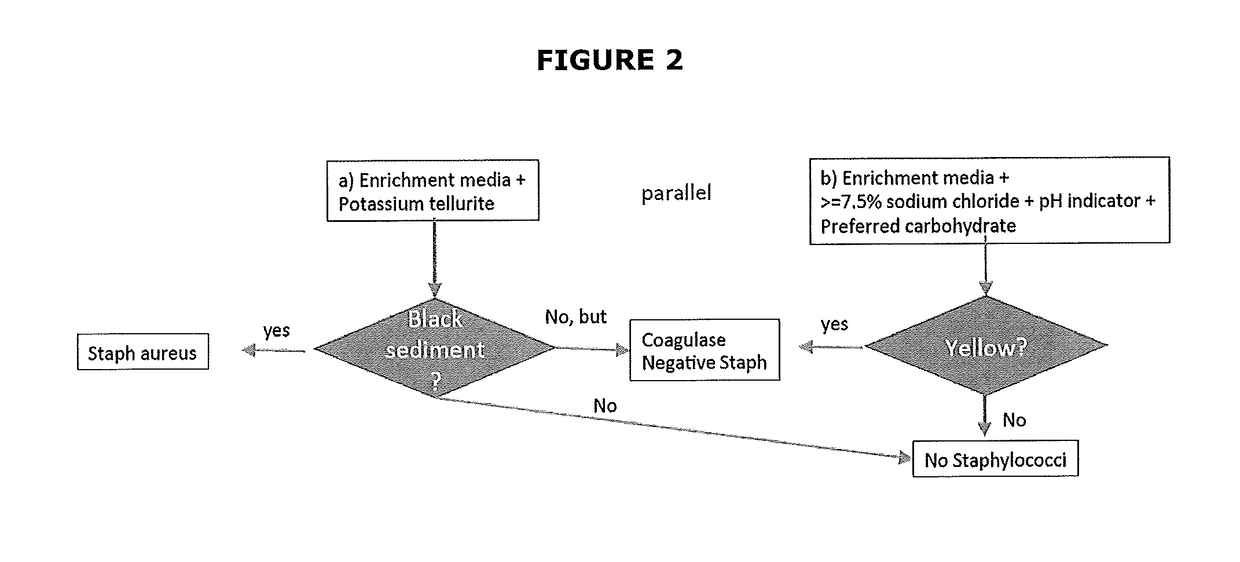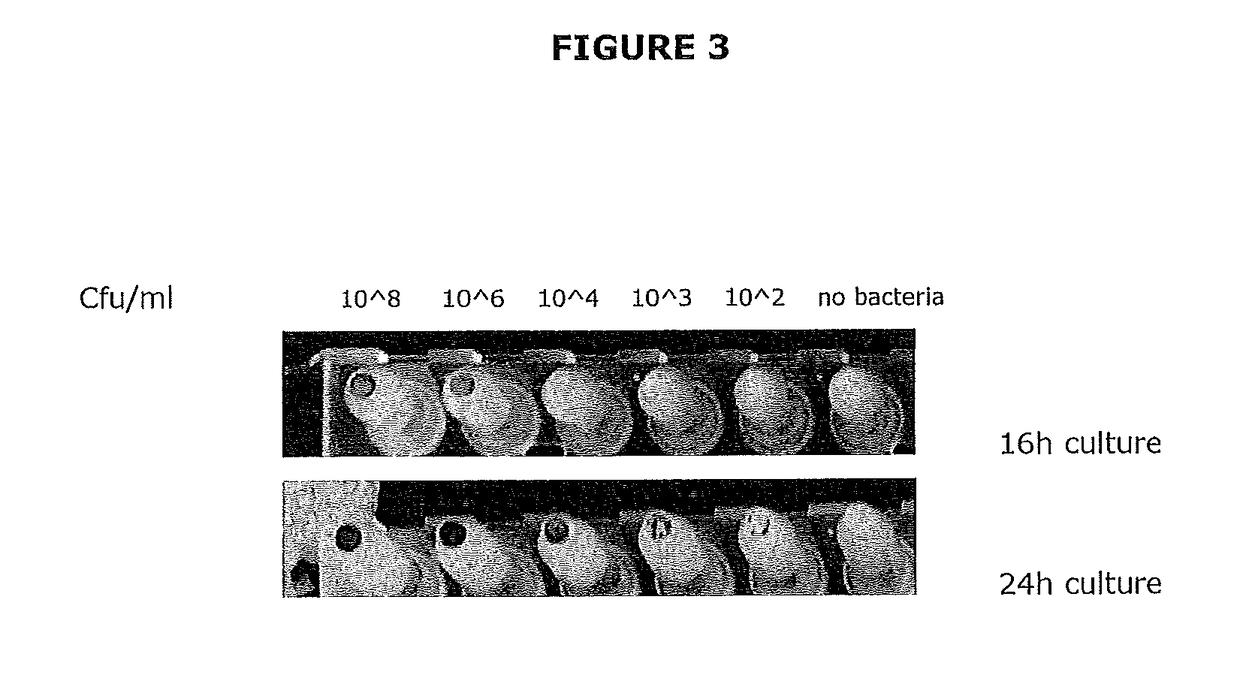Bacteria identification and antimicrobial susceptibility test
a technology of antimicrobial susceptibility and bacteria identification, which is applied in the field of bacteria identification and antimicrobial susceptibility testing, can solve the problems of increasing the challenges facing human and veterinarian healthcare practices, life-threatening and debilitating systemic and localized microbial infections, and affecting the health of patients, and achieves the effect of inhibiting growth
- Summary
- Abstract
- Description
- Claims
- Application Information
AI Technical Summary
Benefits of technology
Problems solved by technology
Method used
Image
Examples
example 1
and Methods
1. Common Enrichment Media for Bacteria Culture
[0256]
Tryptic Soy Broth (pH~7.3) (% w / v)Tryptone (Pancreatic Digest of Casein)1.7%Soytone (Pancreatic diagest of soybean meal)0.3%Glucose (=Dextrose)0.25% Sodium Chloride0.5%Dipotassium hydrogen phosphate0.25% Water97.0% MacConkey Broth (pH ~7.3) (% w / v)Enzymatic digest of gelatine2.0%Lactose1.0%Oxbile0.5%Bromocresol Purple0.001% Water96.499% Esculin Agar (% w / v)Agar1.5%Pacreatic digest of casein1.3%NaCl0.5%Yeast Extract0.5%Heart muscle, solids from infusion0.2%Esculin0.1%Ferric citrate0.05% Water95.85% Esculin Azide Broth (pH ~7.2) (% w / v)Peptic digest of animal tissue2.0%Yeast Extract0.5%Bile salts1.0%Sodium citrate0.1%Esculin0.1%Ferric ammonium citrate0.05% Sodium Azide0.025% Water96.225% Mannitol Salt Agar (% w / v)Agar1.5%Enzymatic digest of casein0.5%Enzymatic digest of animal tissue0.5%Beef Extract0.1%D-Mannitol1.0%Sodium Chloride7.5%Phenol red0.0025% Water88.8975% Mannitol Salt Broth (pH ~7.3) (% w / v)Mannitol0.25% S...
example 2
1. Preliminary Experiments Based on Test Development and Validation
[0282]In this example, the following abbreviations are used: McC=MacConkey broth; TSB=tryptic soy broth
[0283]Gram negative bacteria including E. coli in MacConkey broth plus addition phenol red (enrichment media for coliform bacteria); MacConkey Broth is used for the detection of coliform bacteria in milk and water.
Formula for MacConkey broth g / LEnzymatic Digest of Gelatin20 gLactose10 gOxbile 5 gBromocresol Purple0.01 g
[0284]If gram negative bacteria including E. coli is grown in MacConkey broth plus excess of phenol red then as expected the colour is initially red and turns yellow with the growth of bacteria. Importantly, the yellow colour remains for up to 48 h. Refer to Table 1, below.
[0285]Table 2a shows E. coli grown in a general enrichment media, which is required for antibiotic susceptibility testing. The results demonstrate that with increasing phenol red concentration the intensity...
example 4
occi Identification (Differentiation and Selectivity) in Clinical Samples
[0315]The differentiation of coagulase positive and coagulase negative Staphylococci is often desired. Knowing the type of coagulase Staphylococci can influence the treatment decision.
[0316]Traditionally, differentiation between coagulase positive and negative staphylococci has been performed with the tube coagulase test which detects extracellular staphylocoagulase or the slide coagulase test that detects the clumping factor (bound coagulase) present on the bacterial cell surface.
[0317]Alternatively, The BBL™ Staphyloslide™ Latex Test is a latex slide agglutination test for the differentiation of staphylococci which possess clumping factor and / or Protein A, usually present with Staphylococcus aureus, from staphylococci that do not possess these properties.
[0318]The BBL™ Staphyloslide™ Latex Test consists of blue latex particles coated with human fibrinogen and IgG. On mixing the latex reagent with colonies of ...
PUM
| Property | Measurement | Unit |
|---|---|---|
| time | aaaaa | aaaaa |
| pH | aaaaa | aaaaa |
| temperature | aaaaa | aaaaa |
Abstract
Description
Claims
Application Information
 Login to View More
Login to View More - R&D
- Intellectual Property
- Life Sciences
- Materials
- Tech Scout
- Unparalleled Data Quality
- Higher Quality Content
- 60% Fewer Hallucinations
Browse by: Latest US Patents, China's latest patents, Technical Efficacy Thesaurus, Application Domain, Technology Topic, Popular Technical Reports.
© 2025 PatSnap. All rights reserved.Legal|Privacy policy|Modern Slavery Act Transparency Statement|Sitemap|About US| Contact US: help@patsnap.com



